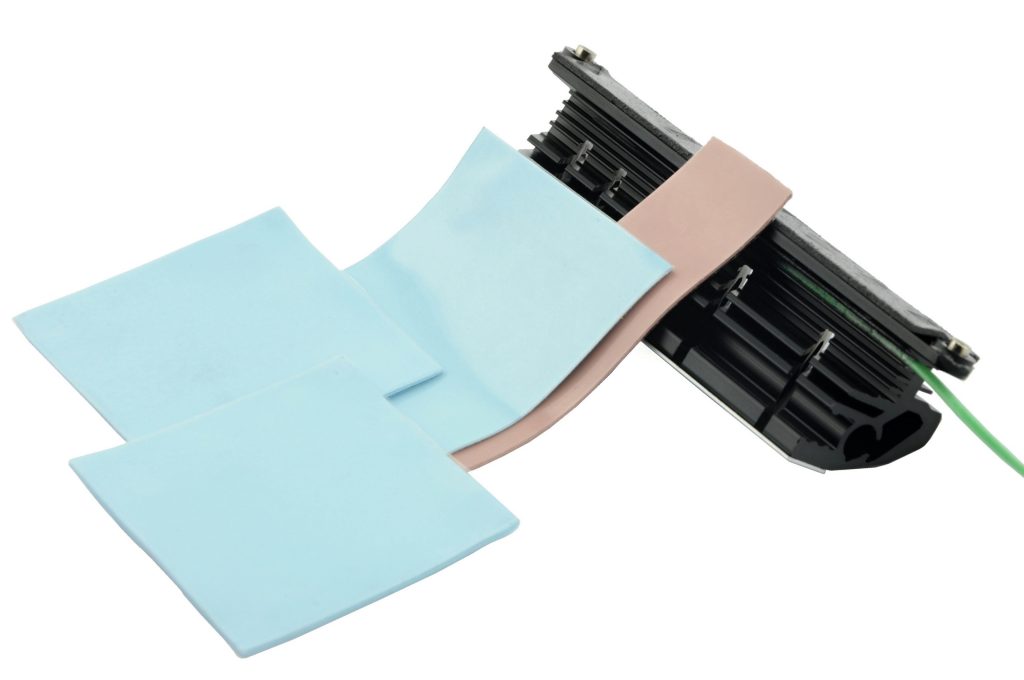Details and test procedures
Thermal conductive pads are useful wherever a thermal paste cannot be reasonably applied. A good example are power supply circuit of graphics cards and processors, so the choice of test subjects was unambiguous. It was less clear, however, what thickness of pads is most effective, if it is better to pay for more expensive ones, and what improvement to expect.
Details
Heating of voltage regulators does not determine just lifespan, but also stability of the system. And we do not even have to think about extremes – it is enough to demand a high performance and low noise level at the same time. The final result can be improved with each Celsius degree.
We have ordered probably the most popular thermal conducting pads for this test – from Arctic. They can be characterized by a relatively low price and great expectations. The manufacturer states on the website that they are significantly more effective than Phobya pads. They come in two sizes (we will be interested in the most common, for one or two uses – 50 × 50 mm) and in three thicknesses: 0.5, 1, and 1.5 mm. We have tested all of them.
Arctic has quite rich specifications on the web, from which you can get a pretty good idea about properties of the material. Thermal conductivity (6 W/mK) and thermal load (-40 ~ +200 ºC) are the key attributes for a better orientation. The opponent from Thermal Grizzly, Minus Pad, should work well in frost (up to -100 ºC) too, making it attractive for extreme overclocking. The upper limit is also somewhat higher (+ 250 ° C), but difficult to fully exploit in real situations. In addition to the higher thermal range and thermal conductivity (8 W/mK), the price is also higher. It costs about 15 € (120 × 20 mm), which is few times more than an Arctic pad with comparable size and thickness.
Thermal Grizzly revealed its composition too – ceramic silicon and nano-aluminum. As well as Arctic pads, they have a relatively low elasticity and higher stiffness. On the other hand, default pads of our test motherboard, Gigabyte Aorus AX370 Gaming 5, are more flexible with lower density.
Test procedures
We measured the temperatures in the CPU Vcore section (the next SOC circuit is heating half less) and subtracted them from four different sources. The first is the internal sensor on the board, the second is just above the base of the heatsink, where we installed a thermocouple, and the remaining two are surface temperatures captured via our thermal imager. Through Fluke SmartView, we were looking for maximum and average temperatures. Except for the temperatures from the internal sensor, the higher the temperature, the better (the more the pad transfers the heat into the heatsink).
In order to test pads properly, Vcore was set to 1.45 V (R7 1800X with 4.03 GHz). This time, tests took place in an open space on a benchtable, but with the powerful airflow of two Nocua NF-A12S fans with max. RPM (~ 1200). You can see the layout in the photo. As usual, we tested with constant air temperature 21 – 21.3 ºC. The burn was simulated in IntelBurnTest (12 GB) for 900 seconds.
Thermal conductive pads are useful wherever a thermal paste cannot be reasonably applied. A good example are power supply circuit of graphics cards and processors, so the choice of test subjects was unambiguous. It was less clear, however, what thickness of pads is most effective, if it is better to pay for more expensive ones, and what improvement to expect.
Gallery of thermal images
These pictures illustrate the heat of the heatsink. The higher the contrast of the coils, the lower the heat transfer through the pad. The weakest one was measured when using Arctic 0.5 mm, the best with the Thermal Grizzly pad.
Thermal conductive pads are useful wherever a thermal paste cannot be reasonably applied. A good example are power supply circuit of graphics cards and processors, so the choice of test subjects was unambiguous. It was less clear, however, what thickness of pads is most effective, if it is better to pay for more expensive ones, and what improvement to expect.
Results
With the same thickness, Thermal Grizzly achieved higher efficiency than the Arctic pad. And the difference of -6 °C (from 86 to 80 ° C) is certainly not negligible. However, you would pay 0.6 € for one cm2, which is significantly more than Arctic (0.2 €/cm2).
There is also a cheaper trick to fix the temperatures – increase the thickness of the pad. Temperatures with Arctic 1.5 mm are similar to those with TG 1 mm. This is obviously due to a combination of several factors. After compression, there is more material (with higher concentration/absorption) for the heat transfer, the MOSFETs are better “submerged“ in the pad, which leads to heat transfer from the edges too, and also more pressure plays its role. For example, when using a pad with a thickness of 0.5 mm, the pressure is relatively low (the VRM prints were rather weak), which probably also contributed to the weakest results. However, it also depends on the distance between the contact area of the heatsink and the surface of the VRM casing. It is usually about 0.4 mm. Original pads used by Gigabyte were of better quality and you could even make thigs a little bit worse by replacing them with Arctic.
After removing the heatsink, the temperatures reached 100 ° C in three minutes (and kept rising). The standard time of all tests was 15 m.
If you would like to give us a tip for a review, feel free to do so in the comment section.
We will be grateful for any feedback!
